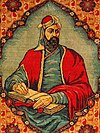 |
| Part of a series on |
| Nizami Ganjavi |
|---|
| The Khamsa or Panj Ganj |
| Related topics |
| Monuments |
|
Nizami Mausoleum • Nizami Museum of Azerbaijani Literature • Nizami Gəncəvi (Baku Metro) • in Ganja • in Baku • in Beijing • in Chișinău • in Rome • in Saint Petersburg • in Tashkent |



Khosrow and Shirin (Persian: خسرو و شیرین) is the title of a famous tragic romance by the Persian poet Nizami Ganjavi (1141–1209), who also wrote Layla and Majnun. It tells a highly elaborated fictional version of the story of the love of the Sasanian king Khosrow II for the Christian Shirin, who becomes queen of Persia.[1][2][3][4] The essential narrative is a love story of Persian origin which was already well known from the great epico-historical poem the Shahnameh and other Persian writers and popular tales, and other works have the same title.[5]
Variants of the story were also told under the title Shirin and Farhad (شیرین و فرهاد).
- ^ The Encyclopædia Iranica ("Ḵosrow o Širin" Archived 2020-11-17 at the Wayback Machine Encyclopædia Iranica, Paola Orsatti)"Two traditions soon formed around the figure of Širin: one in her favor, with its roots in Armenia and in the Christian regions of the Caucasus, where, as we have seen, Neẓāmi found his source; and the second, represented in the Šāh-nāma, where Širin is shown as a woman of humble origin and ill repute, who makes merciless use of poison (in Ferdowsi, Širin, wrought with jealousy, poisons Maryam)."
- ^ The Encyclopædia Iranica ("Farhad" Archived 2020-11-08 at the Wayback Machine Encyclopædia Iranica, Heshmat Moayyad)
- ^ The Khuzistan Chronicle, written by a Syriac Christian from Khuzistan (Beth Huzaye in Aramaic/Syriac) [Iran], probably in 680, is described as the Syriac counterpart of the Armenian work of Sebeos. We read about the relationship between the bishop Isho Yahb and the Persian king Khosrau II Parvez (590–628): "Isho Yahb was treated respectfully throughout his life, by the king himself and his two Christian wives Shirin the Aramean and Mary the Roman". (Theodor. Nöldeke: Die von Guidi herausgegebene syrische Chronik, Wien 1893, p. 10.) The Chronicle of Séert (Siirt) is an anonymously authored historiographical text written by the Nestorian Church in Persia and the Middle East, possibly as early as the 9th century AD. The text deals with ecclesiastical, social, and political issues of the Christian church giving a history of its leaders and notable members. LVIII. – History of Khosrau Parvez, son of Hormizd "Khosrau, by gratitude for Maurice, ordered to rebuild churches and to honor the Christians. He built himself two churches for Marie (Maryam) and a large church and a castle in the country of Beth Lashpar for his wife Shirin, the Aramean." (Patrologia Orientalis, Tome VII. – Fascicule 2, Histoire Nestorienne (Chronique de Séert), Seconde Partie (1), publiée et traduite par Mgr Addai Scher, Paris 1911, Published Paris : Firmin-Didot 1950 p. 467.)
- ^ Johan Christoph Burgel & Christine van Ruyuymbeke, "Nizami: A Key to the Treasure of the Hakim ", Amsterdam University Press, 2011. pg 145: "Shirin is presented as an Armenian princess
- ^ Chelkowski, P. "Nezami's Iskandarnameh:"in Colloquio sul poeta persiano Nizami e la leggenda iranica di Alessandro magno, Roma,1977). pp 10: "The Persian legend of Alexander the Great seems to overshadow all of the other fantastic Alexander stories not only in the tale of the successful accomplishment of many a "mission-impossible" but especially concerning the nature of his career. In Iran he rose from the stature of a damned evil conqueror of the country, to that of a national Iranian hero king, and even more, to that of the great prophet of God, preparing all the nations for the true religion. Yet the Persian legend of Alexander is very little known in the Western world."" pp 13: "Nizami was a typical product of the Iranian culture. He created a bridge between Islamic Iran and pre-Islamic Iran and also between Iran and the whole ancient world. His great humanism, strong character, sensibility, drama, colorful description of nature, rich language, and the poetic genius created a new standard of literary achievements and captured the imagination of countless imitators". pg 17: "In the case of previous romances of Khosraw and Bahram, Nizami dealt with national Iranian heroes, though from pre-Islamic times. In the tale of Layla and Majnun, the Arab nationality of the lover is of no importance since the story is based on a simple Arab folktale which was later absorbed and embellished by the Persians". pp 19: "Alexander was glorified by a small minority of the Muslims as a divine agent, a prophet-king and the blessed conqueror of the lands that were to become the stronghold of Islam. To some Muslims, Islam was a realization of Alexander's "koine" --- a commonwealth where people could live in harmony and in peace of heart and mind. In this atmosphere attempts were made to make out of Alexander not only a Muslim but a Persian as well". pg 21: "However, it was not Tabari directly, but Ferdowsi who was Nizami's source of inspiration and material in composing Iskandarnameh. Nizami constantly alludes to the Shahnameh in his writing, especially in the prologue to the Iskandarnameh. It seems that he was always fascinated by the work of Firdawsi and made it a goal of his life to write an heroic epic of the same stature. pg22: "It seems that Nezami's favorite pastime was reading Firdawsi's monumental epic Shahnameh (The book of Kings)". pg 22: "In fact, although Alexander conquered Iran, he was soon conquered by Persian customs and ways of life. In many aspects he was so overwhelmed by Persian civilization that he became more Persian than the Persians. He tried to make a blend of the Greek and Persian civilization."